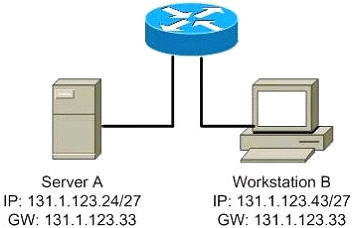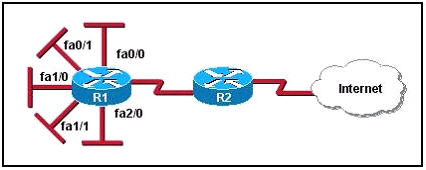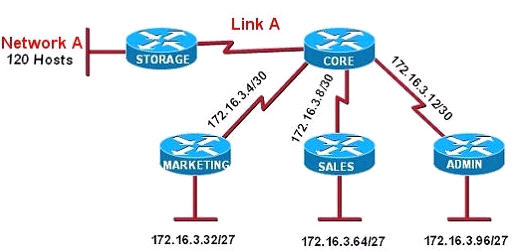CCNA – Subnetting Questions 3
Here you will find answers to Subnetting Questions – Part 3
Note: If you are not sure about Subnetting, please read my Subnetting tutorial.
Question 1
Workstation A has been assigned an IP address of 192.0.2.24/28. Workstation B has been assigned an IP address of 192.0.2.100/28. The two workstations are connected with a straight-through cable. Attempts to ping between the hosts are unsuccessful. What two things can be done to allow communications between the hosts? (Choose two)
A. Replace the straight-through cable with a crossover cable.
B. Change the subnet mask of the hosts to /25.
C. Change the subnet mask of the hosts to /26.
D. Change the address of Workstation A to 192.0.2.15.
E. Change the address of Workstation B to 192.0.2.111.
Answer: A B
Explanation
To specify when we use crossover cable or straight-through cable, we should remember:
Group 1: Router, Host, Server
Group 2: Hub, Switch
One device in group 1 + One device in group 2: use straight-through cable
Two devices in the same group: use crossover cable
-> To connect two hosts we must use crossover cable -> A is correct.
With the subnet mask of /28, 192.0.2.24 & 192.0.2.100 will be in different subnets (192.0.2.24 belongs to subnet 192.0.2.16/28; 192.0.2.100 belongs to subnet 192.0.2.96). To make them in the same subnet we need more space for host. Because 100 < 128 so we the suitable subnet should be /25.
Question 2
Your ISP has given you the address 223.5.14.6/29 to assign to your router’s interface. They have also given you the default gateway address of 223.5.14.7. After you have configured the address, the router is unable to ping any remote devices. What is preventing the router from pinging remote devices?
A. The default gateway is not an address on this subnet.
B. The default gateway is the broadcast address for this subnet.
C. The IP address is the broadcast address for this subnet.
D. The IP address is an invalid class D multicast address.
Answer: B
Explanation
For the network 223.5.14.6/29:
Increment: 8
Network address: 223.5.14.0
Broadcast address: 223.5.14.7
-> The default gateway IP address is the broadcast address of this subnet -> B is correct.
Question 3
Refer to the exhibit. According to the routing table, where will the router send a packet destined for 10.1.5.65?
| Network | Interface | Next-hop |
| 10.1.1.0/24 | e0 | directly connected |
| 10.1.2.0/24 | e1 | directly connected |
| 10.1.3.0/25 | s0 | directly connected |
| 10.1.4.0/24 | s1 | directly connected |
| 10.1.5.0/24 | e0 | 10.1.1.2 |
| 10.1.5.64/28 | e1 | 10.1.2.2 |
| 10.1.5.64/29 | s0 | 10.1.3.3 |
| 10.1.5.64/27 | s1 | 10.1.4.4 |
A. 10.1.1.2
B. 10.1.2.2
C. 10.1.3.3
D. 10.1.4.4
Answer: C
Explanation
The destination IP address 10.1.5.65 belongs to 10.1.5.64/28, 10.1.5.64/29 & 10.1.5.64/27 subnets but the “longest prefix match” algorithm will choose the most specific subnet mask -> the prefix “/29” will be chosen to route the packet. Therefore the next-hop should be 10.1.3.3 -> C is correct.
Question 4
Refer to the exhibit. The user at Workstation B reports that Server A cannot be reached. What is preventing Workstation B from reaching Server A?

A. The IP address for Server A is a broadcast address.
B. The IP address for Workstation B is a subnet address.
C. The gateway for Workstation B is not on the same subnet.
D. The gateway for Server A is not on the same subnet.
Answer: D
Question 5
Given the address 192.168.20.19/28, which of the following are valid host addresses on this subnet? (Choose two)
A. 192.168.20.29
B. 192.168.20.16
C. 192.168.20.17
D. 192.168.20.31
E. 192.168.20.0
Answer: A C
Question 6
Which of the following IP addresses fall into the CIDR block of 115.64.4.0/22? (Choose three)
A. 115.64.8.32
B. 115.64.7.64
C. 115.64.6.255
D. 115.64.3.255
E. 115.64.5.128
F. 115.64.12.128
Answer: B C E
Question 7
The Ethernet networks connected to router R1 in the graphic have been summarized for router R2 as 192.1.144.0/20. Which of the following packet destination addresses will R2 forward to R1, according to this summary? (Choose two)

A. 192.1.159.2
B. 192.1.160.11
C. 192.1.138.41
D. 192.1.151.254
E. 192.1.143.145
F. 192.1.1.144
Answer: A D
Question 8
Refer to the exhibit. All of the routers in the network are configured with the ip subnet-zero command. Which network addresses should be used for Link A and Network A? (Choose two)

A. Network A – 172.16.3.48/26
B. Network A – 172.16.3.128/25
C. Network A – 172.16.3.192/26
D. Link A – 172.16.3.0/30
E. Link A – 172.16.3.40/30
F. Link A – 172.16.3.112/30
Answer: B D
Explanation
Network A needs 120 hosts < 128 = 27 -> Need a subnet mask of 7 bit 0s -> “/25”.
Because the ip subnet-zero command is used, network 172.16.3.0/30 can be used.
Answer E “Link A – 172.16.3.40/30” is not correct because this subnet belongs to MARKETING subnet (172.16.3.32/27).
Answer F “Link A – 172.16.3.112/30” is not correct because this subnet belongs to ADMIN subnet (172.16.3.96/27).
Question 9
Which two subnetworks would be included in the summarized address of 172.31.80.0/20? (Choose two)
A. 172.31.17.4/30
B. 172.31.51.16 /30
C. 172.31.64.0/18
D. 172.31.80.0/22
E. 172.31.92.0/22
F. 172.31.192.0/18
Answer: D E
Explanation
From the summarized address of 172.31.80.0/20, we find the range of this summarized network:
Increment: 16
Network address: 172.31.80.0
Broadcast address: 172.31.95.255
-> Answer D & E belong to this range so they are the correct answers.
Question 10
Which three IP addresses can be assigned to hosts if the subnet mask is /27 and subnet zero is usable? (Choose three)
A. 10.15.32.17
B. 17.15.66.128
C. 66.55.128.1
D. 135.1.64.34
E. 129.33.192.192
F. 192.168.5.63
Answer: A C D
Explanation
First we need to find out the forms of network addresses and broadcast addresses when the subnet mask of /27 is used:
Increment: 32
Network address: In the form of x.x.x.(0,32,64,96,128,160,192,224)
Broadcast address: In the form of x.x.x.(31,63,95,127,159,191,223)
So we only need to check the fourth octets of the IP addresses above. If they are not in the form of network addresses or broadcast addresses then they can be assigned to hosts.
Notice that the IP 66.55.128.1 belongs to the subnet zero and the question says subnet zero is usable so it is valid.
Question 11
Which of the following IP addresses can be assigned to the host devices? (Choose two)
A. 205.7.8.32/27
B. 191.168.10.2/23
C. 127.0.0.1
D. 224.0.0.10
E. 203.123.45.47/28
F. 10.10.0.0/13
Answer: B F
Explanation
This is a time-consuming question (but not hard ^^) because we have to calculate the range of each sub-network separately (excepting answer C is the local loopback address & answer D is a multicast address) so make sure you can do subnet quickly. After solving above questions I believe you can find out the result so I don’t explain this question in detail.
Question 12
How many subnets can be gained by subnetting 172.17.32.0/23 into a /27 mask, and how many usable host addresses will there be per subnet?
A. 8 subnets, 31 hosts
B. 8 subnets, 32 hosts
C. 16 subnets, 30 hosts
D. 16 subnets, 32 hosts
E. A Class B address cant be subnetted into the fourth octet.
Answer: C
Explanation
Subnetting from /23 to /27 gives us 27 – 23 = 4 bits -> 24 = 16 subnets.
/27 has 5 bit 0s so it gives 25 – 2 = 30 hosts-per-subnet.


